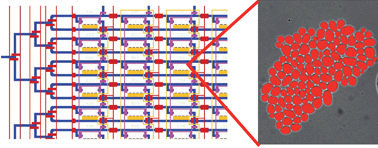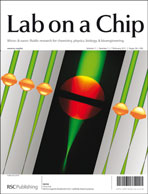High-throughput tracking of single yeast cells in a microfluidic imaging matrix†
Abstract
Time-lapse live cell imaging is a powerful tool for studying signaling network dynamics and complexity and is uniquely suited to single cell studies of response dynamics, noise, and heritable differences. Although conventional imaging formats have the temporal and spatial resolution needed for such studies, they do not provide the simultaneous advantages of cell tracking, experimental throughput, and precise chemical control. This is particularly problematic for system-level studies using non-adherent model organisms such as yeast, where the motion of cells complicates tracking and where large-scale analysis under a variety of genetic and chemical perturbations is desired. We present here a high-throughput microfluidic imaging system capable of tracking single cells over multiple generations in 128 simultaneous experiments with programmable and precise chemical control. High-resolution imaging and robust cell tracking are achieved through immobilization of yeast cells using a combination of mechanical clamping and


 Please wait while we load your content...
Please wait while we load your content...